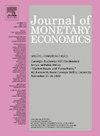Occupational reallocation within and across firms: Implications for labor market polarization
IF 4.3
2区 经济学
Q1 BUSINESS, FINANCE
引用次数: 0
Abstract
This study analyzes how labor market frictions interact with firms’ decisions to reallocate workers across different occupations during labor market polarization. We compare the patterns of occupational reallocation within and across firms in the US and Germany in recent years. We find within-firm reallocation contributes significantly to the decline in employment in routine occupations in Germany, but much less so in the US. We construct a general equilibrium model of firm dynamics and find the model with different firing taxes can replicate the difference in firm-level adjustment patterns across these countries. We conduct two counterfactual experiments for each country, highlighting the different roles played by the within-firm cost of reorganizing the occupational mix and across-firm frictions created by firing taxes. The results suggest the latter plays a more significant role in labor market polarization. Higher firing costs would lead to greater and faster polarization in the US.
企业内部和企业之间的职业再分配:对劳动力市场两极分化的影响
本研究分析了在劳动力市场极化过程中,劳动力市场摩擦如何与企业在不同职业间重新分配工人的决策相互作用。我们比较了近年来美国和德国公司内部和公司之间的职业再分配模式。我们发现,在德国,企业内部的再分配对常规职业的就业下降有显著贡献,但在美国则要小得多。我们构建了一个企业动态的一般均衡模型,并发现不同解雇税的模型可以复制这些国家之间企业层面调整模式的差异。我们对每个国家进行了两个反事实实验,突出了重组职业组合的企业内部成本和解雇税收造成的企业间摩擦所起的不同作用。结果表明,后者在劳动力市场两极分化中起着更重要的作用。更高的发射成本将导致美国出现更大、更快的两极分化。
本文章由计算机程序翻译,如有差异,请以英文原文为准。
求助全文
约1分钟内获得全文
求助全文
来源期刊

Journal of Monetary Economics
Multiple-
CiteScore
7.20
自引率
4.90%
发文量
90
审稿时长
74 days
期刊介绍:
The profession has witnessed over the past twenty years a remarkable expansion of research activities bearing on problems in the broader field of monetary economics. The strong interest in monetary analysis has been increasingly matched in recent years by the growing attention to the working and structure of financial institutions. The role of various institutional arrangements, the consequences of specific changes in banking structure and the welfare aspects of structural policies have attracted an increasing interest in the profession. There has also been a growing attention to the operation of credit markets and to various aspects in the behavior of rates of return on assets. The Journal of Monetary Economics provides a specialized forum for the publication of this research.
 求助内容:
求助内容: 应助结果提醒方式:
应助结果提醒方式:


